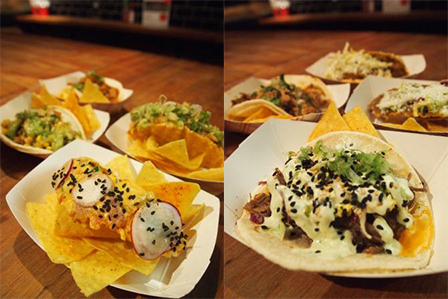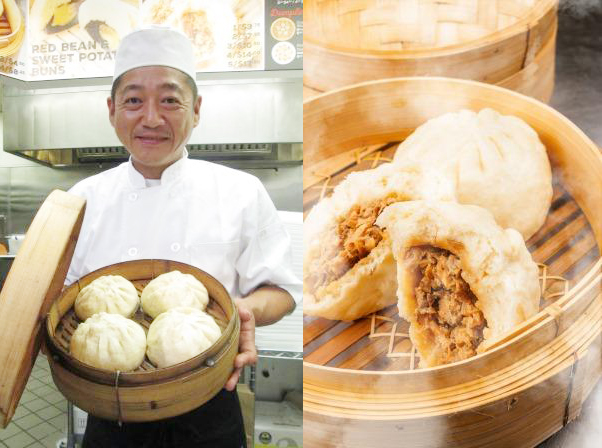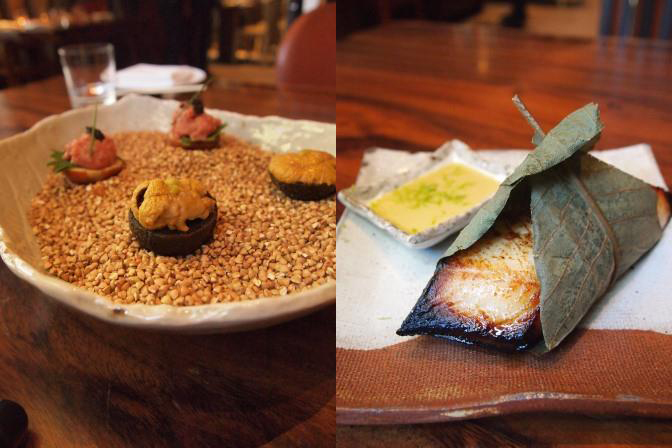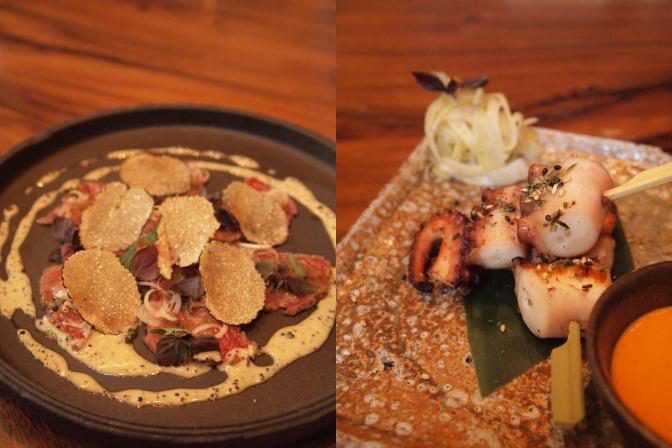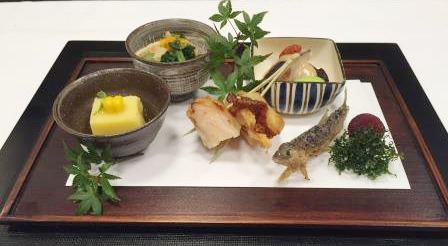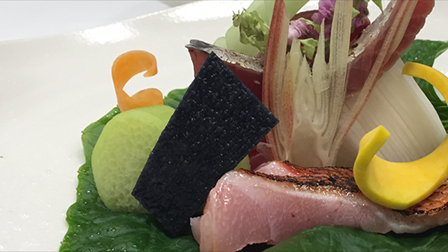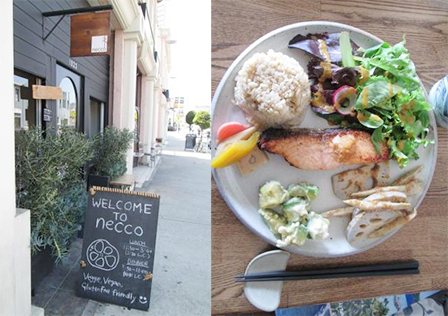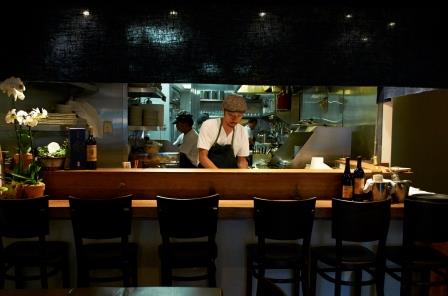Sake Q & A
By Yuji Matsumoto
1. Cold or Hot
Many people think that high quality sake should be enjoyed chilled, but that is wrong. Compared to not needing to worry about the temperature for the better quality sakes, it is better to really chill the poor balanced sakes on the contrary. For one guideline, if it is a refreshing sake that has a flower or fruit type aroma, it’s better to chill them to enjoy the clean cut taste and aroma. On the contrary, for the dry sake with the fermented taste of rice or aroma of sourness etc it’s better to warm it to bring out the fullness of it and seemly make it taste delicious.
2. Which Sake is Better?
Which sake you like changes if the food you like regularly is rich or light so there is no exact answer, but I feel there is a tendency that someone that likes full body red wine will probably like a Junmai Kimoto or Honjozo type sake and someone that likes a young, fruity chardonnay will like a Daiginjo of Niigata prefecture type sake. Matching with the food is extremely important and if you don’t particularly care for drinking the sake by itself, you might make a surprising discovery if you have it with a particular dish so I ask if you will give a try.
3. Tasting Method
Same as wine, drink it while sipping in air. Choose a glass for white wines type, pouring a small amount and lightly mixing it with air is important. If the temperature of the sake is too low it becomes hard to distinguish the aroma so you can slightly warm it with both hands in that case.
4. Drinking Cup
Not only for sake but for wines or beers, it’s amazing that the taste can drastically change depending on the glass. If you want to enjoy the taste and especially the aroma, a small white wine glass is good. For hot sake, so the steam of the alcohol is not smothering, a ceramic type with a slightly large mouth that holds the temperature is good. A wooden square doesn’t go well with aromatic Ginjo types but for sakes with definite body like Junmai types, you can enjoy them with the aroma of Cypress. Please enjoy cold or at room temperature if you have it that way.
日本酒Q&A
1. 冷か燗か
多くの人は、高級酒は冷して飲むと思っているが、これは違う。質の良い日本酒ほど温度にあまりとらわれず飲むことができるのに対して、バランスの悪い酒は、キンキンに冷やした方が逆に良い。
一つの目安としては、花や果実系の香りのするすっきりとした日本酒は、冷した方が味の切れと香りが楽しめる。逆に米の熟成感や酸味などの香りがあるドライな酒は燗をした方が味のふくらみがでて美味しく感じられる。
2. いいお酒はどれ
普段の自分の好む料理がこってり系なのか、あっさり系なのかによっても日本酒の好みも変わってくるので一概には言えないが、フルボディーの赤ワイン系が好きな人は、おそらく純米生もとや本醸造系が気に入るだろうし、若いフルーティーなシャルドネが好きな人は、新潟の大吟醸系が気に入る傾向にある。食事との相性も非常に大事なので、単独で飲んであまり気入らない場合でも、料理と一緒に食べると意外な発見ができるかもしれないので試していただきたい。
3. テイスティング方法
ワインと同じく、空気と一緒にすするように飲む。グラスは、白ワイン系のグラスに少しそそぎ、軽く回し空気と触れさせることが重要。温度があまり低いと臭いが分かりにくいのでその場合は、両手で少し暖める。
4. 飲む器
日本酒に限らず、ワインやビールでもグラスによって味が全く変わるから不思議。味、特に香りを楽しみたいのであれば、小さめの白ワイングラスが良い。熱燗の場合は、アルコールの蒸気が抜け、むせない少し口の大きな陶器系で保温性のあるものが良い。
木の枡は、香る吟醸系にはあまりむかないが、純米などのしっかりとしたボディーの日本酒には、ヒノキの香りが出て美味しく感じられる。その際は、冷か常温で飲む。
1. Cold or Hot
Many people think that high quality sake should be enjoyed chilled, but that is wrong. Compared to not needing to worry about the temperature for the better quality sakes, it is better to really chill the poor balanced sakes on the contrary. For one guideline, if it is a refreshing sake that has a flower or fruit type aroma, it’s better to chill them to enjoy the clean cut taste and aroma. On the contrary, for the dry sake with the fermented taste of rice or aroma of sourness etc it’s better to warm it to bring out the fullness of it and seemly make it taste delicious.
2. Which Sake is Better?
Which sake you like changes if the food you like regularly is rich or light so there is no exact answer, but I feel there is a tendency that someone that likes full body red wine will probably like a Junmai Kimoto or Honjozo type sake and someone that likes a young, fruity chardonnay will like a Daiginjo of Niigata prefecture type sake. Matching with the food is extremely important and if you don’t particularly care for drinking the sake by itself, you might make a surprising discovery if you have it with a particular dish so I ask if you will give a try.
3. Tasting Method
Same as wine, drink it while sipping in air. Choose a glass for white wines type, pouring a small amount and lightly mixing it with air is important. If the temperature of the sake is too low it becomes hard to distinguish the aroma so you can slightly warm it with both hands in that case.
4. Drinking Cup
Not only for sake but for wines or beers, it’s amazing that the taste can drastically change depending on the glass. If you want to enjoy the taste and especially the aroma, a small white wine glass is good. For hot sake, so the steam of the alcohol is not smothering, a ceramic type with a slightly large mouth that holds the temperature is good. A wooden square doesn’t go well with aromatic Ginjo types but for sakes with definite body like Junmai types, you can enjoy them with the aroma of Cypress. Please enjoy cold or at room temperature if you have it that way.
日本酒Q&A
1. 冷か燗か
多くの人は、高級酒は冷して飲むと思っているが、これは違う。質の良い日本酒ほど温度にあまりとらわれず飲むことができるのに対して、バランスの悪い酒は、キンキンに冷やした方が逆に良い。
一つの目安としては、花や果実系の香りのするすっきりとした日本酒は、冷した方が味の切れと香りが楽しめる。逆に米の熟成感や酸味などの香りがあるドライな酒は燗をした方が味のふくらみがでて美味しく感じられる。
2. いいお酒はどれ
普段の自分の好む料理がこってり系なのか、あっさり系なのかによっても日本酒の好みも変わってくるので一概には言えないが、フルボディーの赤ワイン系が好きな人は、おそらく純米生もとや本醸造系が気に入るだろうし、若いフルーティーなシャルドネが好きな人は、新潟の大吟醸系が気に入る傾向にある。食事との相性も非常に大事なので、単独で飲んであまり気入らない場合でも、料理と一緒に食べると意外な発見ができるかもしれないので試していただきたい。
3. テイスティング方法
ワインと同じく、空気と一緒にすするように飲む。グラスは、白ワイン系のグラスに少しそそぎ、軽く回し空気と触れさせることが重要。温度があまり低いと臭いが分かりにくいのでその場合は、両手で少し暖める。
4. 飲む器
日本酒に限らず、ワインやビールでもグラスによって味が全く変わるから不思議。味、特に香りを楽しみたいのであれば、小さめの白ワイングラスが良い。熱燗の場合は、アルコールの蒸気が抜け、むせない少し口の大きな陶器系で保温性のあるものが良い。
木の枡は、香る吟醸系にはあまりむかないが、純米などのしっかりとしたボディーの日本酒には、ヒノキの香りが出て美味しく感じられる。その際は、冷か常温で飲む。






